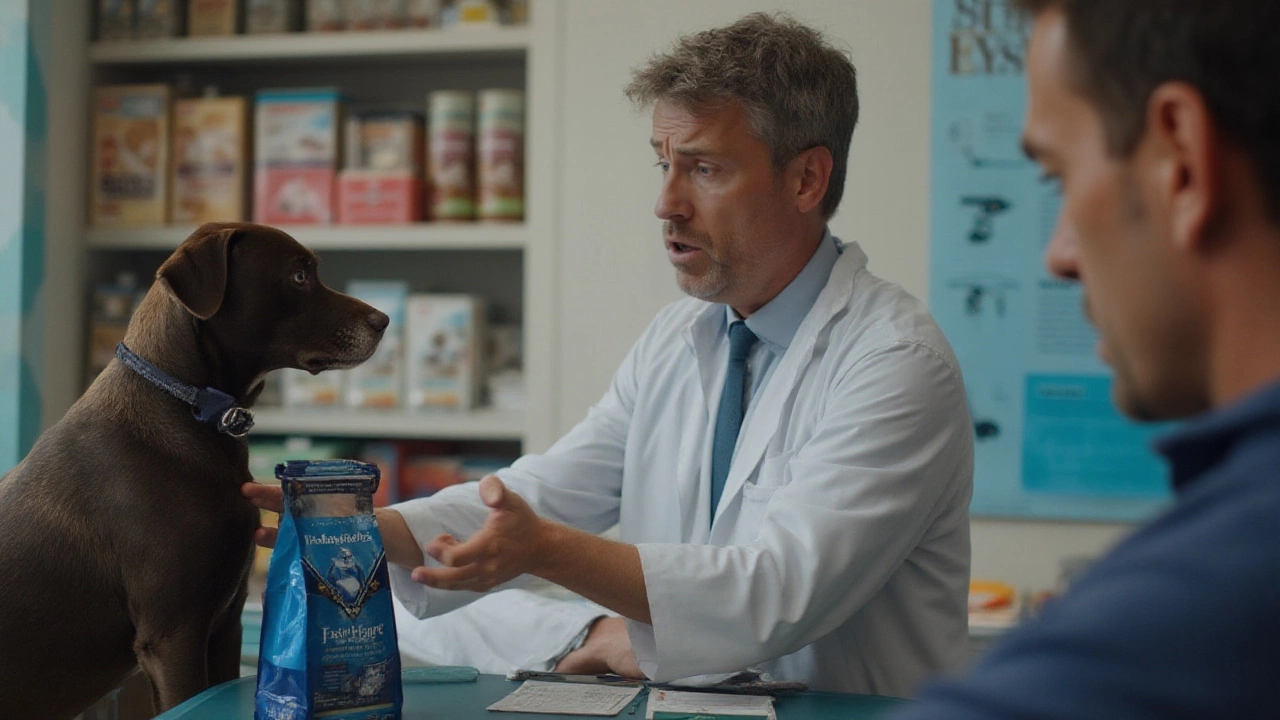There’s a strange little secret at my local dog park. Bring up Blue Buffalo, and suddenly everyone—from the couple with that royal-looking greyhound to the retired vet—has an opinion. A lot of pet owners swear by it, but many vets? Not so much. This divide has nothing to do with snobbery, and everything to do with serious concerns that go deeper than just marketing hype. If someone recommended Blue Buffalo to me for Rex, my dog with a stomach more sensitive than a rainy Wellington picnic, I’d want more than fancy packaging to go on. Why do so many veterinarians give Blue Buffalo a side-eye?
Inside the Bag: What’s Really in Blue Buffalo Dog Food?
Let’s break down why Blue Buffalo has ruffled veterinarians’ feathers. At first glance, the ingredient list looks stellar: “real chicken first,” “no chicken by-product meals,” “grain-free” in bold type. It reads like the menu at a swanky dog-friendly café. But scratch beneath the snazzy font, and the story gets complicated.
- Controversial Ingredients: Blue Buffalo uses a lot of peas, potatoes, and other legume fillers. The FDA has been investigating a possible link between these ingredients and heart disease in dogs—specifically, canine dilated cardiomyopathy (DCM). This hit the news in 2019, and Blue Buffalo was right there on the list of foods being studied. My vet once pointed at Rex’s kibble and asked me if it was "too heavy on peas." Not something you hear every day.
- Changing Ingredient Formulas: Vets also note that Blue Buffalo has changed its recipes several times, often without making it clear on the packaging. So, your dog’s favorite—and tolerated—food might suddenly shift, causing tummy problems or even allergic reactions. That’s not fun for owners or dogs.
- Protein Quality: Unlike foods backed by clinical nutrition research, Blue Buffalo often uses protein "meals," a concentrated powder from meat that's not as high quality as real, whole meat. Some dogs do fine, others get digestive issues.
- Heavy Marketing vs Real Science: The company spends huge sums on advertising that highlights what’s not in their food (like "no by-products", "no corn", etc.). But what matters more—what’s missing, or what’s actually in there? Vets argue it’s often the latter.
Check out some real data on ingredient breakdown:
| Ingredient | % of Recipe (avg.) | Potential Concern |
|---|---|---|
| Peas / Legumes | 25-40% | Linked to DCM in FDA studies |
| Potatoes | 20-30% | High-carb, low-nutrient impact |
| Meat Meals | 12-20% | Lower digestibility than whole meat |
| Whole Proteins | 3-5% | Much less than advertised |
This isn’t just theoretical. After Luna (my cat) sneaked a mouthful of dog kibble, she spent the evening looking about as chipper as a grumpy marmalade. My vet said some formulas, because of all the legumes, can cause stomach issues in both cats and dogs. The thing is, canine and feline digestive systems react really badly to sudden, major changes in fiber and protein sources.

Recalls, Lawsuits, and Reputation Problems
If dog food had a scandal section, Blue Buffalo would feature in several headlines. This isn’t just the odd batch—over the past decade, the brand has faced multiple recalls, and even class-action lawsuits involving false advertising and contamination worries. Ask any vet what makes them uneasy about a pet food, and recalls are always bad news.
- 2010: Massive recall for possible salmonella contamination. That’s a big deal when you’ve got puppies (or, honestly, any dog) with weak immune systems.
- 2015: Recall for too much vitamin D—which can actually poison a dog. That year, Rex’s puppy pal at the park spent days in a vet hospital because her food was from one of those lots.
- 2016–2020: Recalls due to undisclosed poultry by-products, mold, and even pieces of aluminum found in bags. The last one was a shocker—people reported their dogs spitting out sharp, metallic slivers on social media.
There were also class-action lawsuits in the US, where Blue Buffalo admitted some suppliers gave them by-product meals, despite years of advertising that their food never contained those. Trust gets shaky when what’s on the bag doesn’t match what’s in the bowl.
- The Recall Domino Effect: Repeated recalls mean vets start to look for patterns. Sure, any company can slip up once, but a string of incidents makes them rethink recommendations. After the vitamin D issue, my own vet swapped her clinic’s house food away from Blue Buffalo.
- Lack of Research: Big brands like Hill’s and Royal Canin fund dietary studies, run feeding trials, and openly publish data. Blue Buffalo doesn’t, leaving vets comparing anecdotal stories instead of hard facts. For example, a 2021 review in the Journal of the American Veterinary Medical Association found that foods with little or no published trial data were much more likely to cause repeat digestive complaints.
An Australian survey in 2022 asked 900 vets when they’d recommend Blue Buffalo. Only 7% said they'd offer it to dogs with sensitive stomachs or allergies. That’s a red flag for me, as Rex’s digestion has always been a little "high maintenance."

Better Choices: How to Pick the Right Food for Your Dog
Just because Blue Buffalo has some red flags doesn’t mean you have to panic if it’s in your pantry. If your dog is doing really well on it—good energy, shiny coat, no upset tummies—then you’re not doing anything wrong. But if you notice changes when you switch flavors or formulas, or if your vet voices a concern, it’s worth taking a closer look.
- Talk to Your Vet—For Real: Don’t just ask, “Is Blue Buffalo good?” Be blunt: “Would you feed this every day to your own dog?” That one gets a pretty honest answer every time.
- Look Up Brands Backed by Actual Research: Hill’s, Purina Pro Plan, and Royal Canin publish feeding trials and long-term nutrition studies. Their ingredient lists may look boring, but you get peace of mind. When Luna was on a medicated diet last year, my vet showed me trial results right there on her screen.
- Avoid 'Grain-Free' Unless There's a Medical Reason: Most dogs do absolutely fine with high-quality grains—rice, oats, barley. Pea-heavy, legume-heavy diets are trendy but might not suit every dog. That FDA investigation? It focused on grain-free foods, especially ones loaded with potatoes and peas.
- Pay Attention to Your Dog's Poop and Energy: Kind of gross, but it’s the real stuff people measure. If switching foods sends your dog on a diarrhea marathon or suddenly makes them lethargic, flag it with your vet.
- Don’t Get Fooled by Fancy Packaging: A shiny blue bag or the words "ancestral diet" and "superfoods" do not, by themselves, mean better nutrition. Flip that bag and check the breakdown of protein, fat, and fiber—plus where those come from.
Here’s a checklist for picking a dog food that keeps you and your vet happy:
- Start with brands that pass AAFCO (Association of American Feed Control Officials) feeding trials. Not just “formulated to meet”—actually “proven through feeding trials.”
- Check for transparent sourcing: Does the brand openly say where its meat, grains, and vitamins come from?
- Google recent recalls, and reject any pattern of frequent issues.
- Ask your vet: Which foods do they feed their own dogs or clinic mascots? That’s the real test.
When Rex switched from a fancier “super-premium” food to a vet-recommended one, I admit I felt a twinge of guilt—like I was trading in gourmet meals for plain toast. But he’s had better digestion, no skin flare-ups, and more energy to chase Luna on the couch. Sometimes, simple really does win.
If you’re ever on the fence, trust your dog’s signals and keep the conversation open with your vet. It’s the best way to keep your furry sidekick—whether they’re wrestling with the cat or lazing on your favorite armchair—happy for years to come.
